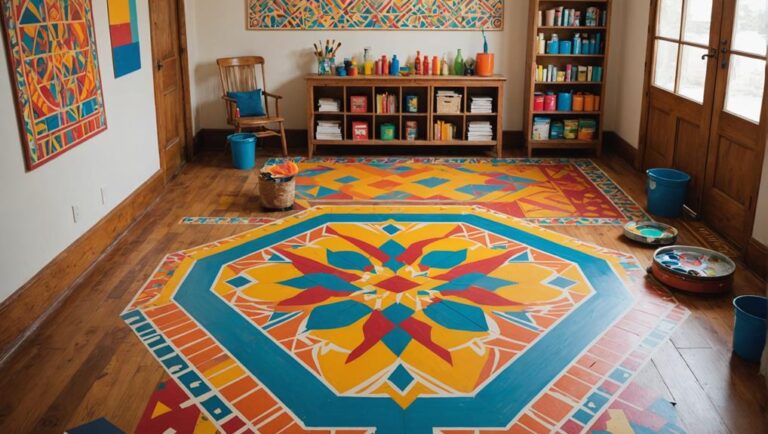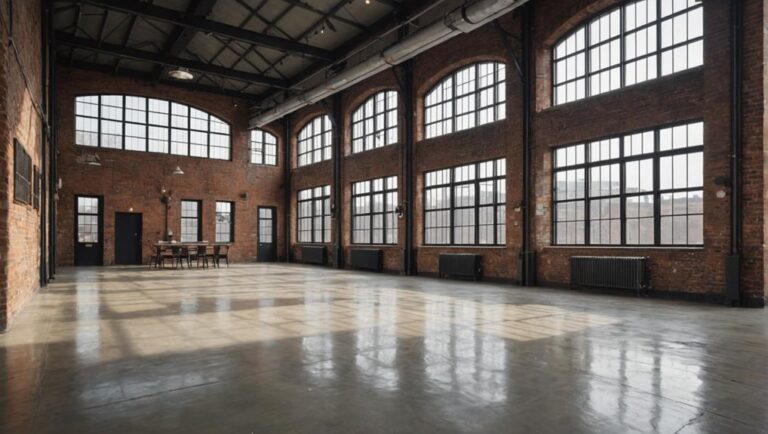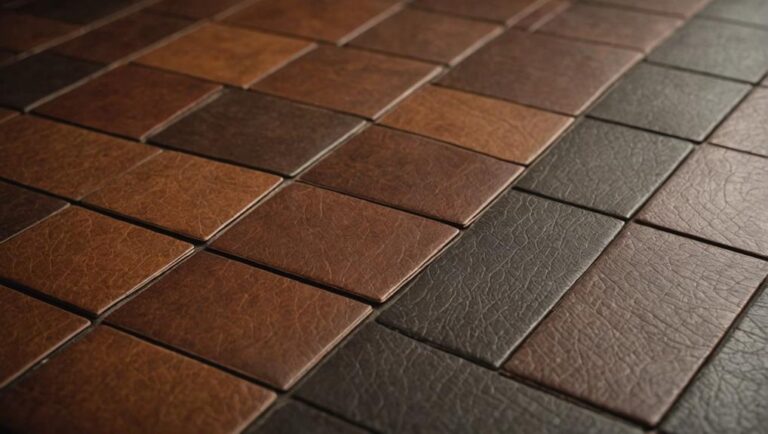To prevent surface wear on high-traffic floors, you'll need a tailored maintenance approach. Start with a daily cleaning routine, sweeping or vacuuming to eliminate dirt that can scratch surfaces. Utilize damp mops and eco-friendly cleaners to maintain aesthetics without causing damage. Consider durable materials with robust finishes like polyurethane for added protection. Employ area rugs and mats at entry points to capture debris and reduce wear. Monitoring humidity levels between 30% and 50% is essential to prevent warping. Regular inspections will help identify issues early, ensuring your flooring remains in prime condition. There's much more effective strategies to explore.
Understanding High-Traffic Areas
In high-traffic areas, where footfall is relentless, understanding the dynamics of wear and tear on flooring is vital. You need to recognize that different traffic patterns can considerably affect the longevity of your floors. High-traffic zones, such as entryways, hallways, and communal spaces, experience concentrated foot traffic, which causes more pronounced wear. Observing these traffic patterns helps you anticipate areas needing more attention and maintenance.
Wear indicators are essential when evaluating the condition of your flooring. These indicators provide visual cues, such as discoloration, scratches, or surface depressions, that signal wear. By monitoring these indicators, you can identify when it's time to take preventive measures before the damage becomes severe. For instance, if you notice a high degree of wear in specific areas, it may be beneficial to implement protective measures, such as placing rugs or mats to absorb some of the impact.
Additionally, choosing the right flooring material plays a considerable role in mitigating wear in high-traffic areas. Durable materials like vinyl, tile, or specific types of hardwood can withstand heavy use better than softer options. Understanding the unique characteristics of your flooring allows you to make informed decisions about its maintenance and protection.
Ultimately, being proactive in monitoring traffic patterns and wear indicators can save you time and money in the long run, ensuring that your flooring remains safe and attractive for years to come.
Regular Cleaning Practices
To effectively prevent surface wear on your floors, establishing a daily maintenance routine is essential. You should identify suitable cleaning products that match your flooring type to guarantee ideal results. Consistent attention to these practices will considerably extend the life of your flooring surfaces.
Daily Maintenance Routine
Maintaining your floors through a daily cleaning routine is essential for preventing surface wear and extending their lifespan. Regular floor care helps you manage the impact of high traffic patterns, which can accelerate wear and tear over time. Start by sweeping or vacuuming the floors daily to remove dirt and debris that can scratch the surface. Make certain to use a vacuum cleaner with a soft brush attachment to avoid damaging delicate finishes.
Next, damp mop the floors with a suitable cleaning solution designed for your specific floor type. This eliminates any remaining dust and grime while providing a gentle clean that won't harm the surface. Pay special attention to areas with the most foot traffic, as these spots are more prone to damage.
Additionally, consider using floor mats at entry points to trap dirt before it reaches your floors. This simple measure can considerably reduce wear caused by abrasive particles. Finally, inspect your floors regularly for any signs of damage or dullness, as early intervention can prevent more extensive repairs down the line. By prioritizing a daily maintenance routine, you'll ensure your floors remain safe, attractive, and durable for years to come.
Suitable Cleaning Products
Choosing the right cleaning products is crucial for maintaining floor integrity and appearance. Using suitable cleaners can greatly reduce surface wear, especially in high-traffic areas. It's important to select eco-friendly cleaners and pH balanced solutions to guarantee safety while effectively cleaning your floors.
When choosing cleaning products, consider the following:
- Eco-Friendly Cleaners: These products minimize environmental impact and are safer for indoor air quality. They help in reducing harmful chemical exposure.
- pH Balanced Solutions: Opt for cleaners that maintain a neutral pH. This prevents damage to floor finishes and extends the lifespan of your flooring material.
- Non-Abrasive Formulas: Avoid products that contain harsh chemicals or abrasives that can scratch or dull the surface of your floors.
Incorporating these cleaning products into your regular maintenance routine will help to preserve the look and longevity of your floors. Always follow the manufacturer's recommendations for specific flooring types to guarantee compatibility and effectiveness. By prioritizing safe and effective cleaning solutions, you'll protect your investment and maintain a clean, attractive environment.
Choosing Durable Flooring Materials
When selecting flooring materials, you'll want to prioritize material strength and longevity to guarantee your investment withstands daily wear. Additionally, consider slip resistance to enhance safety, especially in high-traffic or moisture-prone areas. Finally, understanding the maintenance requirements for each material will help you choose the best option for your lifestyle and upkeep preferences.
Material Strength and Longevity
Selecting the right flooring material is essential for ensuring longevity and minimizing surface wear. When you choose a durable flooring option, you're investing in material durability and wear resistance, which can considerably reduce maintenance costs over time. High-traffic areas require materials that can withstand heavy foot traffic without showing signs of wear.
To help you make an informed decision, consider the following factors:
- Hardness Rating: Opt for materials like hardwood or engineered wood with high Janka hardness ratings for better resistance to dents and scratches.
- Finish Options: Select finishes that enhance durability, such as polyurethane or aluminum oxide, which provide additional protection against wear.
- Maintenance Requirements: Evaluate the upkeep needed for each material; some options may require more frequent refinishing or sealing to maintain their integrity.
Slip Resistance Considerations
Guaranteeing safety in your space involves considering slip resistance as a critical factor in flooring material selection. High-traffic areas, such as entryways and hallways, demand flooring that can withstand wear while providing adequate grip. When choosing durable flooring materials, focus on those with appropriate surface textures. Textured surfaces can greatly enhance traction, reducing the risk of slips and falls.
Look for materials specifically designed with traction enhancements. For example, vinyl, rubber, and certain types of tile can offer superior slip resistance due to their engineered surface profiles. Additionally, consider coatings or treatments that improve grip without compromising the aesthetic appeal of your flooring.
It's important to evaluate the flooring's coefficient of friction (COF), as this metric directly correlates to slip resistance. A higher COF indicates better grip, which is essential for high-traffic environments. Always align your choices with industry standards to guarantee ideal safety for occupants.
Maintenance Requirements and Tips
After ensuring slip resistance in your flooring choices, it's crucial to contemplate the maintenance requirements of those materials to preserve their durability and appearance over time. Choosing durable flooring materials involves understanding how to implement effective preventive strategies that can greatly extend the lifespan of your floors. Regular maintenance not only enhances safety but also minimizes repair costs.
To maximize the effectiveness of your flooring, consider the following tips:
- Apply Floor Coatings: Protective coatings can shield your floors from scratches and wear, making them easier to clean and maintain.
- Establish a Cleaning Routine: Regularly sweep and mop your floors to remove grit and debris that can cause surface damage over time.
- Inspect for Damage: Periodically check for signs of wear or damage, and address any issues promptly to prevent further deterioration.
Implementing Protective Treatments
Protective treatments are vital for maintaining the integrity of your floors against the wear and tear of daily use. Implementing these treatments can considerably extend the life of your surfaces, guaranteeing they remain safe and aesthetically pleasing. One common method involves applying surface coatings, which create a barrier that protects against scratches, stains, and other forms of damage.
When considering treatment application, it's important to choose the right product based on your flooring material. For instance, hardwood floors may benefit from a polyurethane coating, while tile floors may require a different sealing solution. Here's a quick overview of popular surface coatings and their applications:
| Coating Type | Best For |
|---|---|
| Polyurethane | Hardwood |
| Epoxy | Concrete |
| Acrylic | Vinyl |
| Sealant | Tile and Grout |
Before applying any treatment, verify that the surface is clean and free from debris. This preparation step is key to achieving an effective bond and maximizing the protection offered by the coating. After application, it's important to follow the manufacturer's guidelines for drying and curing times to guarantee ideal performance.
Utilizing Area Rugs and Mats
Area rugs and mats serve as an effective strategy for reducing surface wear on floors while adding aesthetic value to your space. By strategically placing these textiles in high-traffic areas, you create a barrier that absorbs impact and minimizes direct contact between shoe traffic and your flooring. This not only prolongs the life of your floors but also enhances the overall look of your environment.
When considering rug placement, it's crucial to choose the right size and style to guarantee they serve their purpose while maintaining safety. Select mats with non-slip backing to prevent accidents, making sure they stay securely in place.
Here are a few tips for maximizing the benefits of area rugs and mats:
- Choose Durable Materials: Opt for rugs made from resilient fibers that can withstand heavy use, such as nylon or polypropylene.
- Regularly Clean and Maintain: Keep your rugs and mats clean to avoid dirt buildup, which can scratch your floors. A vacuum or periodic deep cleaning can make a significant difference.
- Consider Mat Styles: Various mat styles, such as entrance mats or runner rugs, can enhance safety and aesthetics. Position them strategically at entryways and along hallways to capture dirt before it reaches your floors.
Incorporating area rugs and mats into your space is a practical approach to safeguard your flooring while enhancing its visual appeal.
Maintaining Optimal Humidity Levels
Maintaining ideal humidity levels is essential for preserving the integrity of your flooring materials. When humidity levels fluctuate, they can lead to warping, cracking, and other forms of damage that compromise both the appearance and longevity of your floors. To mitigate these risks, effective humidity control is important, particularly in high-traffic areas where wear and tear are more pronounced.
You should aim to maintain indoor humidity levels between 30% and 50%. This range not only protects your flooring but also contributes to a comfortable living environment. To achieve this, consider investing in a reliable hygrometer for moisture monitoring. This device allows you to track humidity levels in real time, helping you take corrective action before problems arise.
If you notice humidity levels consistently outside the ideal range, you may need to employ dehumidifiers or humidifiers based on the conditions of your space. In areas prone to excessive moisture, like basements, dehumidifiers are especially effective in preventing mold growth and structural damage. Conversely, if the air is too dry, a humidifier can help maintain necessary moisture levels.
Regularly check and adjust your climate control systems to guarantee they're functioning at peak performance. By staying vigilant with humidity control and moisture monitoring, you can greatly extend the lifespan of your flooring and maintain its aesthetic appeal. Taking these proactive steps is essential for safeguarding your investment in high-traffic areas where the flooring is subject to constant wear.
Scheduling Professional Inspections
Regularly scheduling professional inspections is essential for identifying potential issues before they escalate into significant problems. Guaranteeing the longevity of high-traffic floors hinges on maintaining an appropriate inspection frequency. Ideally, you should schedule inspections at least twice a year, particularly in environments subject to heavy foot traffic. This proactive approach helps catch wear and tear early, allowing for timely remediation.
When selecting an inspector, prioritize their qualifications. Look for professionals who possess certifications from recognized organizations in flooring and materials science. Their expertise will guarantee they can accurately assess the condition of your floors and recommend appropriate maintenance strategies. An experienced inspector will understand the nuances of different flooring materials and their specific vulnerabilities.
To maximize the benefits of these inspections, consider the following:
- Document Inspection Findings: Keep a detailed record of each inspection's findings and recommendations for follow-up actions.
- Act on Recommendations: Implement suggested repairs or maintenance promptly to prevent minor issues from becoming major concerns.
- Adjust Inspection Frequency as Needed: If your facility's traffic patterns change or if you notice accelerated wear, be prepared to adjust your inspection schedule accordingly.
Frequently Asked Questions
How Often Should I Replace High-Traffic Flooring Materials?
You should consider replacing high-traffic flooring materials every 10 to 15 years, depending on their lifespan and usage. Look out for replacement indicators like visible wear, scratches, or discoloration. If you notice increased difficulty in cleaning or maintenance, it's a sign your flooring may be nearing the end of its useful life. Regular inspections can help guarantee safety and comfort, so don't hesitate to make changes when necessary to maintain a safe environment.
What Are the Best Cleaning Products for High-Traffic Floors?
When it comes to finding the best cleaning products for high-traffic floors, you should consider eco-friendly cleaners that effectively remove dirt without harming the environment. Look for products specifically designed for floor maintenance, ensuring they're safe for both your flooring type and your health. Avoid harsh chemicals; instead, opt for biodegradable options that maintain the integrity of your floors while providing a thorough clean. Regular cleaning with these products helps prolong your flooring's lifespan.
Can I Use Regular Furniture Polish on These Floors?
Using regular furniture polish on your floors is like using a hammer to fix a watch—it's not the right tool. Furniture polish alternatives are often better suited for floor finishes, as they can provide the necessary shine without compromising compatibility. It's essential to guarantee any product you choose is safe for your specific floor finish to avoid damage. Always test a small area first to maintain your floors' integrity and appearance.
How Do I Minimize Noise From Foot Traffic on These Floors?
To minimize noise from foot traffic, consider implementing soundproofing solutions like area rugs or carpet tiles, which can absorb sound effectively. Additionally, using floor cushioning materials can greatly reduce impact noise. Verify your flooring has an underlayment designed for sound insulation; it can dampen vibrations. Regularly maintaining these features will enhance their performance, contributing to a quieter environment while verifying safety and comfort in high-traffic areas.
Are There Specific Footwear Types That Cause More Damage to Floors?
Imagine a dance floor, where every step tells a story. Some footwear materials, like hard plastics or metal heels, can turn this dance into a battle, scratching and scuffing the surface. On the other hand, rubber soles and soft heels glide gracefully, leaving minimal marks. To protect your floors, choose footwear wisely—avoid those with aggressive heel types. Your choice can transform a chaotic waltz into a harmonious experience, ensuring safety and longevity for your floors.




